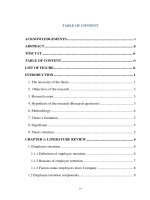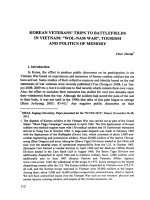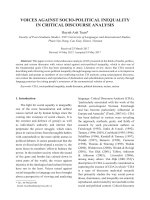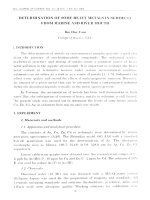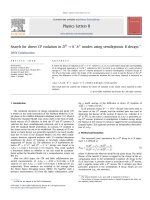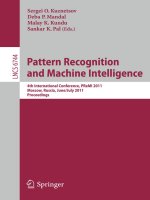DSpace at VNU: Retaining skilled employee, case study in Mai Diem textile & garment limited company
Bạn đang xem bản rút gọn của tài liệu. Xem và tải ngay bản đầy đủ của tài liệu tại đây (139.47 KB, 5 trang )
Retaining skilled employee, case study in Mai
Diem textile & garment limited company
Phạm Thu Hà
Khoa Quản trị Kinh doanh
Luận văn Thạc sĩ ngành: Quản trị Kinh doanh; Mã số: 60 34 05
Người hướng dẫn: TS. Nguyễn Danh Nguyên
Năm bảo vệ: 2012
Keywords. Quản trị kinh doanh; Quản trị nhân lực; Công nhân dệt may; Nguồn
nhân lực
Content
TABLE OF CONTENT
ACKNOWLEDGEMENTS .................................................................................................i
ABSTRACT ..........................................................................................................................ii
TÓM TẮT ........................................................................................................................... iv
TABLE OF CONTENT ..................................................................................................... vi
LIST OF FIGURE .............................................................................................................. ix
INTRODUCTION................................................................................................................ 1
1. The necessity of the thesis ............................................................................................ 1
2. Objectives of the research ............................................................................................. 3
3. Research scope.............................................................................................................. 3
4. Hypothesis of the research (Research questions) ......................................................... 3
6. Methodology ................................................................................................................. 4
7. Thesis‟s limitation ........................................................................................................ 5
8. Significant ..................................................................................................................... 5
9. Thesis structure ............................................................................................................. 5
CHAPTER 1: LITERATURE REVIEW .......................................................................... 6
1.1Employee retention ....................................................................................................... 6
1.1.1 Definition of employee retention ........................................................................ 6
1.1.2 Reasons of employee retention ........................................................................... 7
1.1.3 Factors make employees leave Company ........................................................... 8
1.2.Employee retention components ................................................................................. 9
1.2.1 Work environment and Job Design ...................................................................... 9
1.2.2 Leadership ........................................................................................................11
1.2.3 Employee Recognition, Rewards and Compensation ......................................13
1.2 Employee retention tactics
14
1.3.1 Employee Compensation..................................................................................15
1.3.2 Employee Benefits ...........................................................................................16
1.3.3 Employee Recognition and Reward Program ..............................................18
1.3.4 Job satisfaction .................................................................................................20
1.3.5 Creating a comfortable work environment .......................................................22
1.3.6 Coaching programmes ......................................................................................24
1.3 Employee retention in Garment and textile industry …………………………25
1.4.1 Overview on Vietnam‟s garment and textile industry .....................................25
1.4.2 Human resource management and development solution ................................26
CHAPTER 2: ANALYSIS OF MAI DIEM’S EMPLOYEE RETENTION .............. 29
2.1 Overview of Mai Diem Garment and Textile Company………………………..29
2.2 The Research methodology……………………………………………………..30
2.2.1 Overall approach ..............................................................................................30
2.2.2 Questionnaire development ..............................................................................31
2.2.3 Target Population .............................................................................................32
2.3 Findings and analysis………………………………………………………….33
2.3.1 Benefit programs ..............................................................................................33
2.3.2 Strategies............................................................................................................ 41
2.3.3 Organizational culture ....................................................................................... 49
2.3.4 Employee Satisfaction ....................................................................................... 57
CHAPTER 3: RECOMMENDATION AND CONCLUSION ....................................... 68
3.1 Overview of the current human resource system at Mai Diem.................................. 68
3.2 Recommendation for Mai Diem Garment and Textile Company ........................... 68
3.2.1 Clear Objectives about work climate ................................................................. 68
3.2.2Training and Motivation ....................................................................................... 70
3.2.3 Benefits and Compensation ............................................................................... 71
3.2.4 Communication and Assistance......................................................................... 72
3.2.5 Create belief for the employees in the future development of Mai Diem…….73
3.3 Action plan ................................................................................................................. 74
3.3.1 The action plan in long term .............................................................................. 74
3.3.2 The proposed action plan in short term to attract newcomers and
sustain current employees from the researcher: ............................................................ 77
CONCLUSION .................................................................................................................. 80
REFERENCE ..................................................................................................................... 82
APPENDIX ......................................................................................................................... 84
References
1.
Dawson.C, 2009, “How to decide upon a methodology: Introduction to Research
Methods (4th Edition), USA: How To Books Ltd.
2.
Coff, R. W. (1997). Human Assets and Management Dilemmas: Coping with Hazards
on the Road to Resource-Based Theory. The Academy of Management Review, 374402 .
3.
Davidow, W.H., Uttal, B. (1989), Total Customer Service: The Ultimate Weapon,
Harper and Row, New York, NY, .
4.
Reichheld, F.F. (1995), "Loyalty and the renaissance of marketing", Marketing
Management, Vol. 2 No.4, pp.10-21
5.
Stauss, B., Chojnacki, K., Decker, A., Hoffman, F. (2001), "Retention effects of a
customer club", International Journal of Service Industry Management, Vol. 12 No.1,
pp.7-19.
6.
Zineldin, M. (2000), TRM Total Relationship Management, Student litterateur, Lund.,
.
7.
McGovern, P. (1995). „To retain or not to retain? Multinational firms and technical
labour,‟
8.
Arthur, J. (1994), „Effects of human resource systems on manufacturing performance
and turnover. ‟ In Academy of Management Journal.
9.
Bame, S.I. (1993). „Organizational characteristics and administrative strategies
associated with staff turnover.‟ In Health Care Management Review, v18, n4, pp. 7086.
10.
McKeown, ,. L. (2002). Retaining Top Employees. Blacklick, OH, USA: McGrawHill Companies.
11.
Mai
Diem
garment
and
textile
ltd
Company,
“Annual
report”,
2006,2007,2008,2009,2010.
12.
Grant.C, 1984, “Employee Motivation: Principles and practices.” USA: Vantage
Press
13.
PhillipsJJ;
Connel.A.O, 2003, “Managing employee
accountability approach.” USA: Butterworth-Heinemann
retention:
a
strategic
14.
Bowen, R. B. (2000). Recognizing &Rewarding Employees. OH USA: McGraw-Hill
Professional Book Group.
15.
Debra F, C. (2002). Expanding Paradigms in Providing Internal Service.
ManagingService Quality, 87-99.
16.
Fields (2001). Indispensable Employees : How to Hire Them, How to KeepThem.
Franklin Lakes, NJ, USA: Career Press, Incorporated.
17.
Ian M, T., &Jonathan, W. (2007). The importance of management style in
labourretention. International Journal of Sociology,5-1 8.
18.
Milman, A. a. (2004). Predicting job retention of hourly employees in the lodging.
Journal of Hospitality and Tourism Management Vol. I I No. 1,23-41
19.
Rarnlall,
S.
(2003).
Managing
Employee
Retention
as
a
Strategy
for
IncreasingOrganizational Competitiveness. Applied H R. M. Research, VOL 8, NO 2,
63-67
20.
Silbert, L. (2005). The effect of Tangible Rewards on Perceived Organizational
Support. Management Sciences. Retrieved from Management Sciences
21.
Human Resource Institute (2001). Loyalty and commitment: a survey on attracting
and retaining workers.
22.
Chaminade, B. (2006). Staying Power. HR Monthly, March 2006. Article pp. 44-45.
23.
Jordan, M. (2010). Leadership of the future: Strategies for success.

